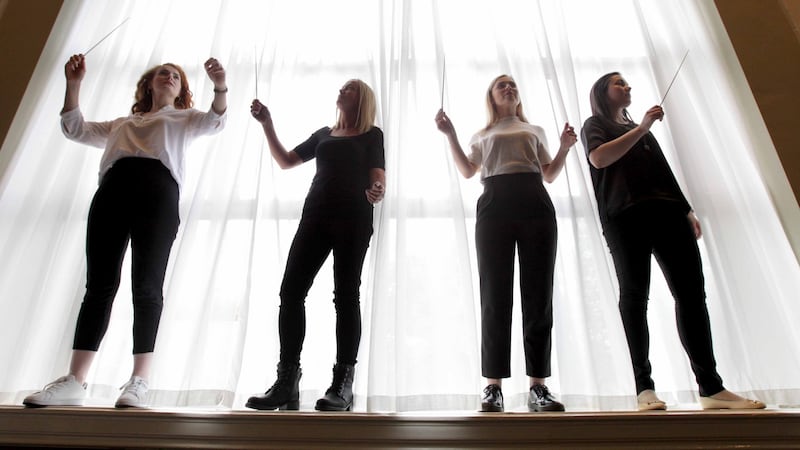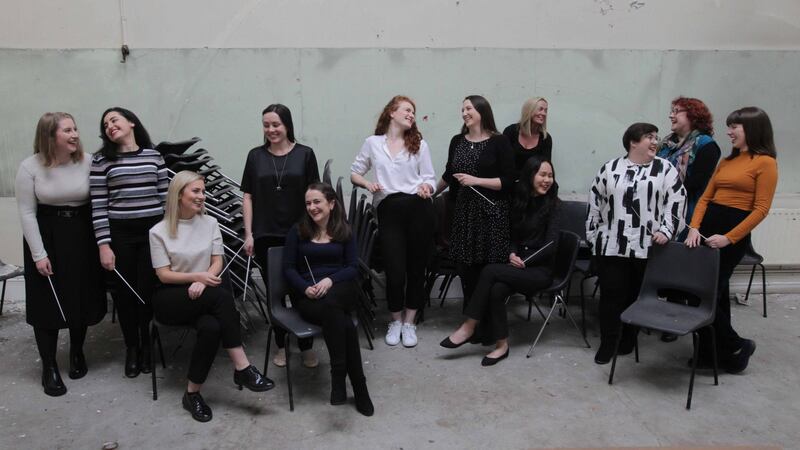When the world-famous American conductor, Marin Alsop became the first female conductor to take to the podium to conduct, Last Night at the Proms in 2013, her presence sparked a debate both inside and outside classical music circles. Why had it taken so long for a woman to lead the BBC Symphony orchestra at one of these popular, prestigious events in the British musical calendar?
“Historically, there was only one type of conductor – the dictator maestro, the old man on the podium, but that has changed and conductors behave much better now,” says Alice Farnham, world-renowned conductor and artistic director of female conductor programmes including one at the National Concert Hall (NCH) in Dublin.
Without wanting to dwell too much on the historical legacy of this particular male bastion of power, Farnham adds, “If you don’t have role models, it’s much harder to see yourself as a conductor – and there were male musicians who wouldn’t see themselves as conductors either.”
Farnham has managed to increase the percentage of female conductors in Britain from a meagre 1.4 per cent to a modest 6 per cent in eight years
Marin Alsop, who retired from her job as conductor/musical director of the Baltimore Symphony Orchestra in 2021, is undoubtedly an excellent high-profile role model for women. Not only did she blaze a trail in conducting but she also set up one of the first women-only training programmes, the Taki Alsop Conducting Fellowship to support aspiring female conductors.
Disappointingly, when Alsop retired in 2021, the top 25 orchestras in the United States were once again, all led by male conductors in spite of growing numbers of prominent female conductors.
However, Marin Alsop’s conducting of the Last Night at the Proms spurred Farnham to do something to increase the numbers of female conductors on this side of the Atlantic Ocean. “I said at the time, that it’s not good enough that women don’t want to be conductors,” she explains.
And through her female conductor training programmes, Farnham has managed to increase the percentage of female conductors in Britain from a meagre 1.4 per cent to a modest 6 per cent in eight years. In Ireland, the chief conductor of the National Symphony Orchestra is male (Jaime Martin) although female guest conductors have included Nathalie Stutzmann, Sinead Hayes and Eimear Noone. Elaine Kelly is the resident conductor with the Irish National Opera.

“I’m hopeful that things are improving – but the danger is that young women will get jobs before they are ready – and women are forgiven less if they don’t get it right early in their careers. It’s important not to try to fix the problem immediately but to let conductors develop,” adds Farnham.
On Monday, January 31st, Farnham will give the participants of the second run of the female conductor programme at the NCH a chance to practice their skills in front of an audience (NCH Main Stage from 6pm-7.30pm and livestreamed on the NCH YouTube channel) as the final event of their training.
She says that it’s important to note that “it’s a public event, not a concert”.
Aine Gell speaks about the attraction of developing your own sound as a conductor, depending on how players react to you
“I’ll be speaking with them and allowing them to try things. It’s a process that will be lovely for the audience to see. People are fascinated by what conductors do and hopefully this will shine through,” she says.
Unlike musicians, conductors can’t practice on their own (apart from assiduously studying the musical scores in advance) so rehearsals with the orchestra are crucial learning experiences.
“Rehearsals are where you gain confidence with the orchestra. It’s a multitasking job of listening, leading, thinking ahead all the time and tying it all together. The rehearsal process is really important - when it comes to the performance, the conductor’s is leading and inspiring the musicians,” says Farnham.
The 12 participants of the current NCH Female Conductor programme – Aine Gell, Amy Ryan, Margaret Bridge, Celine Leong, Dara Pender, Emily Cox, Muireann Ni Dhubhghaill, Siobhan O’Donnell, Siofra Ní Dhubhghaill, Mary Walsh, Meadhbh Campbell and Tamasine Plowman – are all talented and accomplished musicians with academic training in music – some of which includes conducting programmes.

A few of them join me at the NCH in advance of the programme finale to speak about what they’ve learned and what has motivated them to pursue a career as a conductor.
“To stand on the podium and see other people, whose collective experience is much greater than yours, looking for your direction is so daunting but we’ve learned not to start with that mindset and to see ourselves as constantly developing,” says Emily Cox.
Aine Gell speaks about the attraction of developing your own sound as a conductor, depending on how players react to you. “Different conductors get different sounds from an orchestra, depending on their gestures, eye contact and presence on the podium and I learned as much from watching the others conduct as I did when I was on the podium myself,” she says.
Irish conductor Eimear Noone, who became the first female conductor to take to the podium at the Oscars in 2020, joined them on a training webinar in 2021
Catriona Clarke, one of the participants in the first NCH female conductor programme eloquently describes how she had to get to grips with the physicality of being a conductor. “The sound is at the end of the baton. It’s up to you to shape that sound from the moulding of your finger tips to your whole hands. It’s more difficult than it looks.”
Another participant in the first NCH female conductor programme, Molly de Burca described it more about getting used to taking up the space and using that space. “It’s about learning how much space to take up as a conductor and use it to your advantage and to the orchestra’s advantage. The things you think you may be exaggerating too much, actually look quite small.”
They all agree on the importance of female role models and are cogently aware that while there are many talented female choral conductors in Ireland, there are still very few female conductors of professional orchestras.
Irish musician, composer and conductor, Eimear Noone, who became the first female conductor to take to the podium at the Oscars ceremony in February 2020, joined them from the United States on a training webinar in 2021.
At the webinar, she said, “we have to create positions to address imbalance of culture – both for women and minorities – at student level. We can’t have more women at the podium if we lose them early on. We need to encourage young artists to embrace opportunities created for women. And having friends who are conductors is so important.”
Paul Jacobs, partner at Grant Thornton, the accounting and consulting firm which supports the NCH female conductor programme both financially and with training, says that to become a successful female conductor requires more than technical skills. In many ways, Jacobs says, it is even more difficult than the corporate world as jobs are often got through word of mouth without being advertised.
“You need to know your market, have the confidence to seek opportunities, be a good communicator and networker and understand the psychology of negotiating to get paid enough,” he explains. Many of the participants on the second programme who speak to the Irish Times says that they benefited hugely from public speaking workshops, led by Grant Thornton.
In an interview with the New York Times on her retirement, Alsop pointed to the need for a support system for female conductors. “The old boy’s network has been there for centuries. We have to create the old girl’s network, so that we can really be there for each other and support each other.”
Claire Gibault, French conductor and co-director of La Maestra, the academy for women conductors in France also told the participants in the aforementioned webinar that solidarity is crucial. "We must hire other women in positions of responsibility – conductors, musical directors, on juries and teaching panels. Women must not remain the exception. We need to build a new musical world with men."
James Murphy, chief executive of the Royal Philharmonic Society in the UK (and former orchestra manager at the South Bank Sinfonia) says that managers need to explore new names and seek opinions about people they don’t know. “It’s time to broaden your long list and spend time considering female and male conductors. There is a tendency to fixate on the ‘top new things’ and the venerable elders but between those two bookends is a lot of talent,” says Murphy, who also joined the aforementioned webinar.
Farnham agrees that it is still harder [for women] to move into certain professional orchestras. “But being a conductor is something you have to devote your life to, even if you don’t earn very much money. It’s a difficult thing to dabble in. If you want to do it properly, you have to take it seriously enough to say, “I am a conductor, this is what I do.”




















